The first half of this century shopping meant either a trip into Peterborough for major purchases, generally by train, horse and cart or later by bus, or to the ‘shop around the corner’ for everyday necessities. These were the days before every family owned at least one car.
The village shops could provide most of your daily needs. In addition they were a centre of social life, where people could meet and swap the latest news and gossip. Village shops are also likely to employ local people returning some of the money back into the local economy.
Some shops and businesses have stood the test of time but others have disappeared into the pages of history. Do you remember Harry Cureton and his bottles of sweets, Bunties Cafe which was almost opposite the Leads Hall, the original Co-Op that is now the dentist or the Barclays Bank that was where Toddlers Inn is now located?
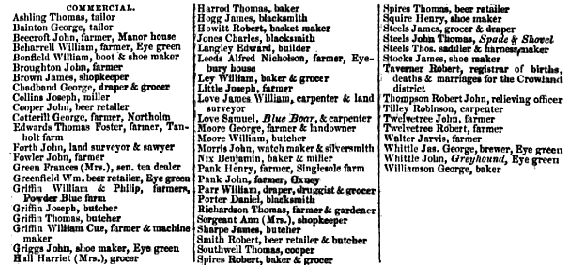
As you can see from the list above in the 1800s the village had everything needed to be self-supporting, farmers to grow the crops, millers to grind the corn and bakers to make the bread. If you needed your shoes fixing you would go to William Bonfield or James Stockes, if you needed some furniture you may have visited Robinson Tilley, all within the village.
For the first half of this century the village had, at any one time, at least four general stores and a minimum of five public houses. As late as the Second World War there was still a metalsmiths in the village. Milk, meat, groceries and coal were often delivered by bike, by van or by horse and cart.
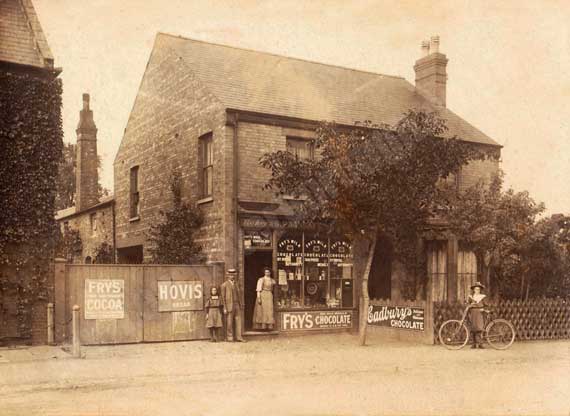
When World War Two arrived so did rationing. The aim was to prevent food shortages. Local people registered with one of the local shops in the village and received their rations weekly, the shops like the Co-Op were provided with enough food for registered customers. Purchasers had to take ration books with them when shopping. By April 1945 produce like Bacon and Ham was rationed to 4oz (113g) a week, sugar, 8oz (227g) and butter 2oz (57g).
The shop keeper would take the used coupons and would be allocated credit notes to purchase more goods. By the 4 July 1954 when rationing ended it was shown to have improved the health of British people; infant mortality declined and life expectancy rose, discounting deaths caused by hostilities. This was because it ensured that everyone had access to a varied diet with enough vitamins.
Milk would originally be delivered from a local source by horse and cart but by the 1970s the majority of milk delivered in the village was by Horrels or the Co-op milk dairies in the city. Both companies had electric vehicles that would deliver milk in glass bottles door to door. Many people will still remember the rattle of the milk bottles being delivered early in the morning and the quiet whir of the electric motor of the milk float. Milk delivery in this form has virtually died out over the past decade, another casualty of the growth of supermarkets.
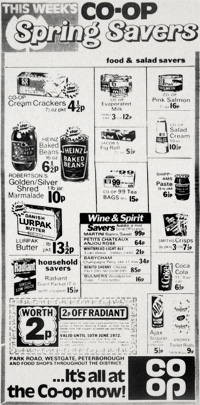
A 1960s shopping list (for comparison sakes prices have been decimalised)
A loaf of bread………………………….6p (1s.2d)
3lb white flour…………………………8p (1s.3d)
1lb leg of pork……………………….20p (4s.0d)
1lb of cooked ham………………….40p (8s.0d)
Half lb of margarine…………………..4p (8d)
A pint of milk…………………………….4p (8d)
1lb of cheese………………………..15p (3s)
1lb of onions………………………….3p (7d)
2lbs of white sugar…………………..8p (8d)
20 cigarettes………………………..22p (4s.5d)
By 1970
A loaf of bread…………………………9p (1s.4d)
A pint of milk……………………………5p (1s)
The 70’s brought in decimalisation and high inflation, the retail price index reached over 25% by 1975, by the 1980’s the worst was over but the damage was done.
1980 prices
A loaf of bread…………………………33p
A pint of milk……………………………17p
On a side note average salaries were around £2,000 a year in 1971, with the average home selling for £5,632; in essence, less than three times earnings. Today (2011) average earnings are around £25,000 and the average house is £238,874, 10 times the average earnings!
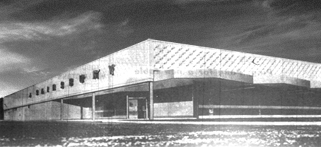
The 1970s also saw the establishment of the ‘weekly shop’ in large supermarkets and the arrival of decimalisation. The supermarkets would lead to widespread change in our shopping habits and many of the smaller shops across the village would end up closing over the next 20 years.
Before decimalisation money was stated in pounds, shillings, and pence, 12 pence(d) was a shilling(s) and 20 shillings(£) was a pound. On 15 February 1971, the UK decimalised, replacing the shilling and penny with a 100 new pennies, £1 12s 6d became £1.62½. The word “new” was omitted from coins after 1981. In 1965 a can of beans was 9d, that’s 4p in today’s money, adjusted for inflation that’s 48p today! The pound comes from Anglo-Saxon England and was equal to 240 silver pennies which is equivalent to one pound in weight of silver, this evolved into the modern British currency.
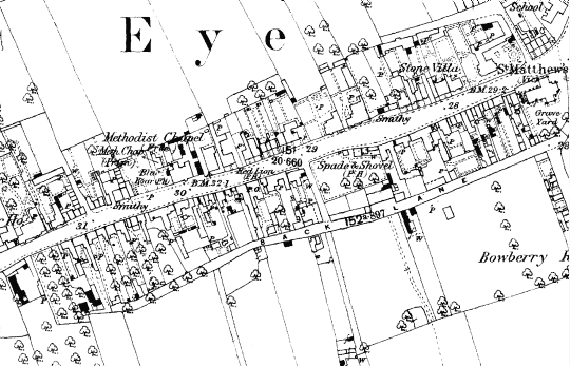
In 2014 the shops and businesses going from Peterborough Road in the west and along the high street to Thorney Road were:
- Edgerly Park Car Sales
- Eye Dental Care
- Roberts Hair Dressers
- The Oasis
- Weldon’s Fisheries
- Eye Pizza and Kebab House
- Co-op
- Pearl City
- Post Office
- Shapers
- Eye Village Stores
- Boots
- Webbs Motorcycles
- Dalton Seeds
- Pioneer Caravans.
Businesses are constantly changing as our expectations and needs change. In the 1900s the blacksmiths, pubs and grocery shops dominated the village high street. Today it’s dominated by takeaways, hairdressers and car sales. Times have changed and Eye has within a fifteen minutes drive, a variety of shops and supermarkets selling everything they could possibly need every day of the week.
Peterborough Garden Park, an out-of-town retail centre to the western edge of the parish opened in 2010. Since opening it was won a number of awards. The property is anchored by a 50,000 sq ft Van Hage garden centre. Van Hague has been dubbed the ‘John Lewis’ of Garden Centres. Other retailers at the 18.5 acre site at opening included Cotswold Outdoor, The Works, The Edinburgh Woollen Mill and Bonmarche. In 2018 the park was acquired by the company Targetfollow and in 2020 an Aldi supermarket opened up on the site.
The main roads that pass through the parish have also seen development including a McDonalds, Starbucks, Greggs, KFC and a Travelodge.
The last decade has seen also seen the advent of the internet. Village businesses such as Victoria Little Kitchen which may have required a shop 20 years ago, nowadays use the web as their shop window.
Older residents are not necessarily convinced that the changes have been for the better – they remember the convenience of a shop just around the corner. With the rise of supermarket shopping (where we now buy 97% of our food) and increasing car usage, most of the smaller grocery shops were forced out of business although there has been some return to the local shop over the past decade.
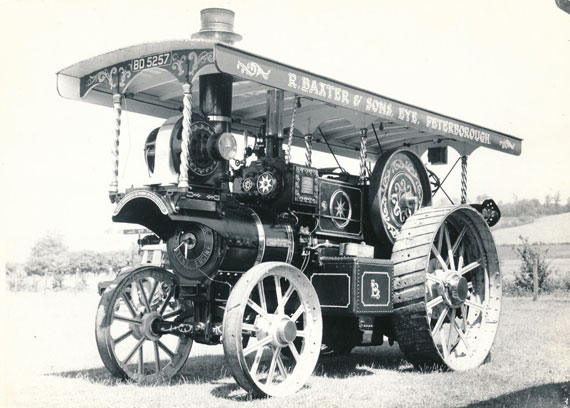
Links
Local Works: http://www.localworks.org
Join me in the 1900’s: http://www.1900s.org.uk/1900s-shopping.htm

We still get our milk delivered in Bottles on Eye High Street … Milk And More
Very interesting, regarding shops in Eye. Do you have any information on James Sharpe Butchers, were they a chain of shops perhaps with one in Peterborough, or any connection with London.